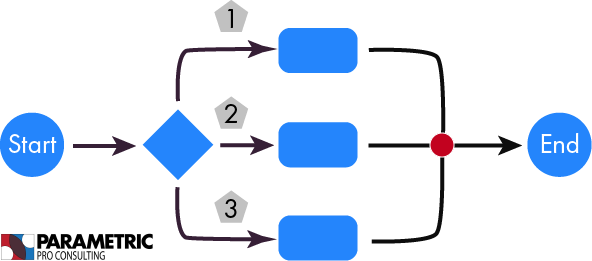At Parametric Pro, we believe that almost every process can be converted into a mathematical algorithm, procedure, or long term initiative to handle the majority of daily business. We believe in using process flows to reduce costs, increase revenues, and ensure that your operations are lean and efficient.
This post will walk you through what a process flow is, what they’re used for, and some tips on creating an effective process flow for your business.
What Is a Process Flow?
Process flows provide visual overviews of all the tasks and relationships involved in a given process from initiation to completion. The three main reasons you might want to use a process flow are to visualize a process, explain how a process works, and to improve upon a given process.

How To Use Process Flows
Visualizing a Process
One of the most common reasons for using process flows is to provide a visual representation of a given process. You may want to create an internal document for training purposes, or maybe a client-facing document to help explain why your company is different from the competition.
What if you’ve never created a process flow before? Don’t worry! There are plenty of tools out there to help you visualize your process, like LucidChart, Google Jamboards, or even just a whiteboard in the office.
Explaining How a Process Works
Processes can become opaque over time as someone takes ownership of them. This is called “institutional knowledge”. You’ve probably heard someone say something (or have said yourself) like:
- “Give that to Fred, he handles those.”
- “Laura deals with that.”
- “That’s Jim’s call.”
It’s good that you have people who are good at what they do, but how will you go about explaining these processes to new employees, stakeholders, or executives if Jim, Fred, or Laura leave the company?
Process flows help remedy this by creating a way for you to explain processes more effectively, in a standardized format that is easy to follow and understand.
Improving a Process
Nearly every company has at least one process that has not been updated in quite some time. There are a few ways that process flows can improve upon these old processes to increase competitiveness, efficiency, and scalability in your organization.
You can usually find some great ways to improve old processes just by mapping them out and looking for any redundancies, bottlenecks, inefficiencies, lack of planning, and more. By weeding these out and standardizing your processes, you’ll be able to better implement Key Performance Indicators, benchmark your best practices, and automate repetitive tasks.
Another way you can improve processes is by mapping out the current process, then mapping out the optimized version of the same process and working to transform the current process into the optimized one. By breaking down the current process into granular steps, you can identify areas for improvement in places that you probably never thought to examine before.
Tips For Using Process Flows
After deciding on a process flow to map, there are some key points to consider:
Make sure that the foundation of your process is a strong one, ensuring that you account for all processes involved in the flow down to the most basic level. One way to approach this is the top down method - start with the high level activities like sales or production, and break them down into more granular steps.
For example, sales can be broken down into the processes of lead identification, lead qualification, first contact (through phone or email), followup (through phone, email, or meetings), closing, and finally signing the contract.
Breaking down and analyzing one granular process at a time will allow you to identify and isolate the root causes of inefficiencies and problems.
Develop a RACI (Responsibility, Accountability, Consulted, Informed) matrix for each task in the process. This lets you easily see who is performing the task, who makes sure it was done correctly, who else has any sort of input on the task, and who needs to know when the task is completed.
Do not make changes as you analyze each granular task. These tasks can influence others, so work your way through the basic tasks back up to the high level processes before implementing changes.
It might seem tedious to go through each process one by one rather than looking at the whole organization at once, but this method ensures that you address each process as thoroughly as possible, reducing the risk of missing a critical flaw or optimization.
Even though you’ll be going through each process one at a time, make sure you account for how changes in one process or task will affect other processes or tasks, at both high and low levels.
Try to make sure any arrows or lines don’t cross, as that can become confusing to viewers, defeating what the purpose of the process flow was in the first place.
Each icon on the diagram should represent a single action or decision, to minimize any confusion.
If this article was helpful to you, please consider sharing it with your network!
For more useful information, check out our other Insights!
If you need help creating or optimizing a process flow, book a free consultation call with us.
Are you interested in the consulting industry? Parametric Pro Consulting Foundations offers more in-depth knowledge on this article as well as several other topics to prepare you for a career in business and consulting. Check it out here!
